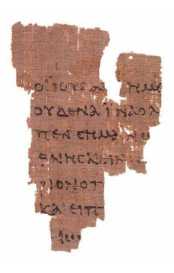
From time to time I hear people say that the New Testament has been significantly changed since it was first written, so we cannot have any confidence in we are reading. Who knows if it is an accurate reflection of what the original authors wrote?
Eminent scholar Bart Ehrman’s 2005 book Misquoting Jesus suggests “how radically the text has been altered over the years”.
Is the situation really as ‘bad’ as that? What are the facts? I have spent some time checking the matter out.
The ‘bad’ news
The New Testament was written long before the age of printing, so every copy of a document had to be made by hand. And eventually the original and later copies wore out or were lost. As a result, the New Testament we read is reconstructed from more than 5,600 Greek manuscript copies of all or various parts of the New Testament, plus about 20,000 manuscripts in other languages.
When these 25,000 manuscripts are compared, numerous variations are found – perhaps as many as 400,000 – about three variations for every word in the whole New Testament!
So there is a problem. Which of the variations are the original ones?
The good news
It turns out that the situation isn’t as ‘bad’ as it first appears.
- The vast majority of variations are so minor (an obvious mis-spelling or a change in word order) they don’t affect the meaning. Other variations (e.g. omission of whole lines or repetition of words) are so obvious that they can be easily discarded.
- Only a very small percentage of variations make any significant difference. In his book, Ehrman lists about 40, but even most of them make little difference to our understanding.
- The only real significant variations included two major passages and two small passages that were probably not in the original documents, and about 5 changes of a word or two that make minor differences – for example, whether Jesus was angry or moved with compassion when he healed a man, and whether another passage describes Jesus as God or son of God.
- Because there are so many manuscript copies, scholars have plenty of information on which to base a reconstruction where this is necessary.
- Most of these variations have long been recognised and most have been corrected in modern Bibles, but in a few of these 9 variations, the original isn’t clear and most Bibles indicate this by a footnote.
- The result is that just a couple of verses in the Bible you read are possibly unoriginal, and no teachings depend on the verses alone.
Conclusion
We can actually be fairly confident we have a text very close to the original. There is far less to worry about than I thought when I began to investigate this matter.
I have summarised my more detailed findings in The reliability of the New Testament text
Photo: The earliest New Testament manuscript so far discovered, a fragment of John’s gospel dated about 30 years after the original – from Wikipedia.
“Although Rylands 52 is generally accepted as the earliest extant record of a canonical New Testament text,[2] the dating of the papyrus is by no means the subject of consensus among scholars. The style of the script is strongly Hadrianic, which would suggest a most probable date somewhere between 117 CE and 138 CE. But the difficulty of fixing the date of a fragment based solely on paleographic evidence allows a much wider range, potentially extending from before 100 CE past 150 CE.”
Also from Wiki.
A clearerr statement than the comment “The earliest New Testament manuscript so far discovered, a fragment of John’s gospel dated about 30 years after the original”
Yes, a clearer statement, but much longer (and I try not to have my blog posts too long), and not much different.
John is often thought to have been written about 95 CE, so 30 years afterwards is about 125 CE, which is the date of the sources I used. The middles of the ranges you have quoted are 127/8 CE and 125 CE, which makes my shorter summary quite accurate.
Only the full text has no ambiguous undertones.
[…] Virtually all scholars, regardless of religious belief or lack of it, are confident Jesus was a historical person (see Bart Ehrman on did Jesus exist and The Jesus myth wars heat up). Most scholars also accept that the gospels give us good historical information about Jesus, although there is considerable variation in exactly how reliable they believe them to be (see Archaeology and Jesus and How reliable is the New Testament text?). […]